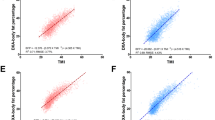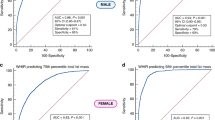Abstract
Background/objectives
Due to the increase in childhood obesity, identifying children with excess body fat as early as possible is essential. Body mass index (BMI) is commonly used as a marker of body fat in children, adolescents, and adults, yet whether BMI is a valid marker of body fat in pre-school aged children remains to be confirmed. Therefore, we analyzed the associations of BMI with fat and fat-free mass in healthy 4-year-old Swedish children.
Subjects/methods
The study comprised of 303 children (135 girls) participating in the MINISTOP obesity prevention trial. Fat and fat-free mass were measured using air displacement plethysmography and we computed fat mass index (FMI) and fat free mass index (FFMI) as fat and fat free mass (kg)/height2 (m).
Results
BMI was positively yet weakly associated with percent fat mass (boys: r2 = 0.120, P < 0.001 and girls: r2 = 0.224, P < 0.001). There was a strong association between BMI and the FMI (boys: r2 = 0.468, P < 0.001 and girls r2 = 0.598, P < 0.001) as well as between BMI and the FFMI (boys: r2 = 0.621, P < 0.001 and girls: r2 = 0.499, P < 0.001). Children classified as normal weight had a wide range of percent fat mass (12.3 to 35.3%) and FMI (1.75 to 5.78 kg/m2).
Conclusions
BMI was strongly associated to both FMI and FFMI. Therefore, caution is needed when interpreting body fat status based on BMI values in pre-school children.
This is a preview of subscription content, access via your institution
Access options
Subscribe to this journal
Receive 12 print issues and online access
$259.00 per year
only $21.58 per issue
Buy this article
- Purchase on Springer Link
- Instant access to full article PDF
Prices may be subject to local taxes which are calculated during checkout

Similar content being viewed by others
References
World Health Organization. Facts and figures on childhood obesity, 2014. Available at: http://www.who.int/end-childhood-obesity/facts/en (last accessed August 2017).
Rokholm B, Baker JL, Sorensen TI. The levelling off of the obesity epidemic since the year 1999--a review of evidence and perspectives. Obes Rev. 2010;11:835–46.
World Health Organization. Obesity and overweight, 2016. Available at: http://www.who.int/mediacentre/factsheets/fs311/en (last accessed August 2017).
Wells JC. Toward body composition reference data for infants, children, and adolescents. Adv Nutr. 2014;5:320S–329S.
Jensen NS, Camargo TF, Bergamaschi DP. Comparison of methods to measure body fat in 7-to-10-year-old children: a systematic review. Public Health. 2016;133:3–13.
Javed A, Jumean M, Murad MH, Okorodudu D, Kumar S, Somers VK, et al. Diagnostic performance of body mass index to identify obesity as defined by body adiposity in children and adolescents: a systematic review and meta-analysis. Pediatr Obes. 2015;10:234–44.
Peterson CM, Su H, Thomas DM, Heo M, Golnabi AH, Pietrobelli A, et al. Tri-ponderal mass index vs body mass index in estimating body fat during adolescence. JAMA Pediatr. 2017;171:629–36.
Forsum E, Flinke Carlsson E, Henriksson H, Henriksson P, Lof M. Total body fat content versus BMI in 4-year-old healthy Swedish children. J Obes. 2013;2013:206715.
Sijtsma A, Bocca G, L’Abee C, Liem ET, Sauer PJ, Corpeleijn E. Waist-to-height ratio, waist circumference and BMI as indicators of percentage fat mass and cardiometabolic risk factors in children aged 3-7 years. Clin Nutr. 2014;33:311–5.
L’Abee C, Visser GH, Liem ET, Kok DE, Sauer PJ, Stolk RP. Comparison of methods to assess body fat in non-obese six to seven-year-old children. Clin Nutr. 2010;29:317–22.
Mei Z, Grummer-Strawn LM, Pietrobelli A, Goulding A, Goran MI, Dietz WH. Validity of body mass index compared with other body-composition screening indexes for the assessment of body fatness in children and adolescents. Am J Clin Nutr. 2002;75:978–85.
Cole TJ, Fewtrell MS, Prentice A. The fallacy of using percentage body fat as a measure of adiposity. Am J Clin Nutr. 2008;87:1959–1960.
Delisle C, Sandin S, Forsum E, Henriksson H, Trolle-Lagerros Y, Larsson C, et al. A web- and mobile phone-based intervention to prevent obesity in 4-year-olds (MINISTOP): a population-based randomized controlled trial. BMC Public Health. 2015;15:95.
Nystrom CD, Sandin S, Henriksson P, Henriksson H, Trolle-Lagerros Y, Larsson C, et al. Mobile-based intervention intended to stop obesity in preschool-aged children: the MINISTOP randomized controlled trial. Am J Clin Nutr. 2017;105:1327–35.
Leppanen MH, Nystrom CD, Henriksson P, Pomeroy J, Ruiz JR, Ortega FB, et al. Physical activity intensity, sedentary behavior, body composition and physical fitness in 4-year-old children: Results from the MINISTOP trial. Int J Obes. 2016;40:1126–33.
Lohman TG. Assessment of body composition in children. Pediatr Exerc Sci. 1989;1:19–30.
Cole TJ, Lobstein T. Extended international (IOTF) body mass index cut-offs for thinness, overweight and obesity. Pediatr Obes. 2012;7:284–94.
Kleinbaum DG. KL, Nizam A, Muller KE. Applied regression analysis and other multivariable methods. 4th edn. Belmont, CA, USA: Thomson; 2008.
Freedman DS, Wang J, Maynard LM, Thornton JC, Mei Z, Pierson RN, et al. Relation of BMI to fat and fat-free mass among children and adolescents. Int J Obes. 2005;29:1–8.
Castro-Pinero J, Artero EG, Espana-Romero V, Ortega FB, Sjostrom M, Suni J, et al. Criterion-related validity of field-based fitness tests in youth: a systematic review. Br J Sports Med. 2010;44:934–43.
Fomon SJ, Haschke F, Ziegler EE, Nelson SE. Body composition of reference children from birth to age 10 years. Am J Clin Nutr. 1982;35:1169–75. 5 Suppl
McCarthy HD, Cole TJ, Fry T, Jebb SA, Prentice AM. Body fat reference curves for children. Int J Obes. 2006;30:598–602.
Delisle Nystrom C, Henriksson P, Alexandrou C, Lof M. The tanita SC-240 to assess body composition in pre-school children: an evaluation against the three component model. Nutrients. 2016;8:E371.
Wells JC, Fewtrell MS. Measuring body composition. Arch Dis Child. 2006;91:612–7.
Fields DA, Allison DB. Air-displacement plethysmography pediatric option in 2-6 years old using the four-compartment model as a criterion method. Obesity. 2012;20:1732–7.
Ahrens W, Pigeot I, Pohlabeln H, De Henauw S, Lissner L, Molnar D, et al. Prevalence of overweight and obesity in European children below the age of 10. Int J Obes. 2014;38:S99–107.
Wikland KA, Luo ZC, Niklasson A, Karlberg J. Swedish population-based longitudinal reference values from birth to 18 years of age for height, weight and head circumference. Acta Paediatr. 2002;91:739–54.
Acknowledgements
The MINISTOP team would like to thank all of the children and parents that participated in this study.
Funding
The MINISTOP project was funded by the Swedish Research Council (project no. 2012-2883) (ML), the Swedish Research Council for Health, Working Life and Welfare (2012-0906) (ML), Bo and Vera Axson Johnsons Foundation (ML), Karolinska Institutet (ML), and the Swedish Nutrition Foundation (CDN). PH was supported by grants from Henning and Johan Throne-Holst Foundation and the Strategic Research Area Health Care Science, Karolinska Institutet/Umeå University and HH was supported by grants from the Swedish Society of Medicine and the County Council of Östergötland, Sweden.
Author information
Authors and Affiliations
Corresponding author
Ethics declarations
Conflict of interest
The authors declare that they have no conflict of interest.
Rights and permissions
About this article
Cite this article
Delisle Nyström, C., Henriksson, P., Ek, A. et al. Is BMI a relevant marker of fat mass in 4 year old children? Results from the MINISTOP trial. Eur J Clin Nutr 72, 1561–1566 (2018). https://doi.org/10.1038/s41430-018-0133-y
Received:
Revised:
Accepted:
Published:
Issue Date:
DOI: https://doi.org/10.1038/s41430-018-0133-y
This article is cited by
-
Changes in body composition by age and obesity status in preschool-aged children: the STEPS study
European Journal of Clinical Nutrition (2021)



